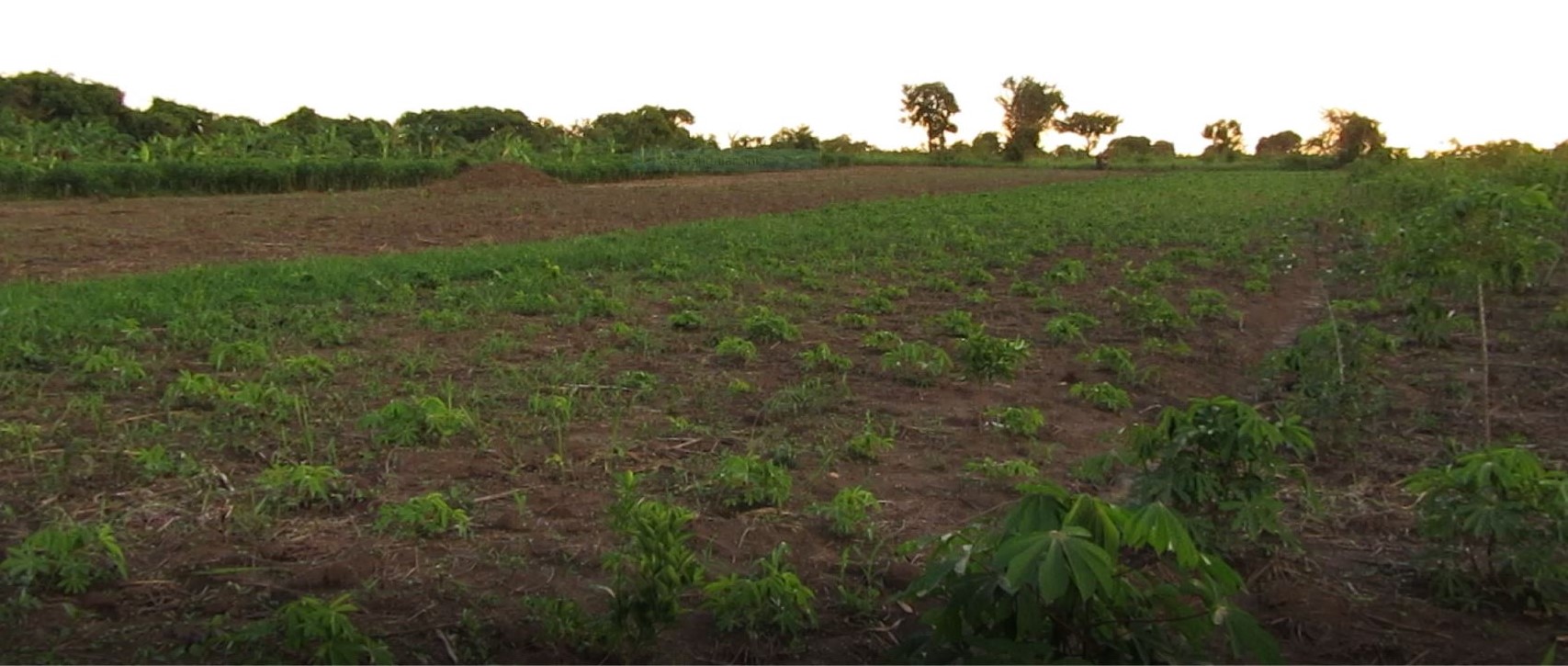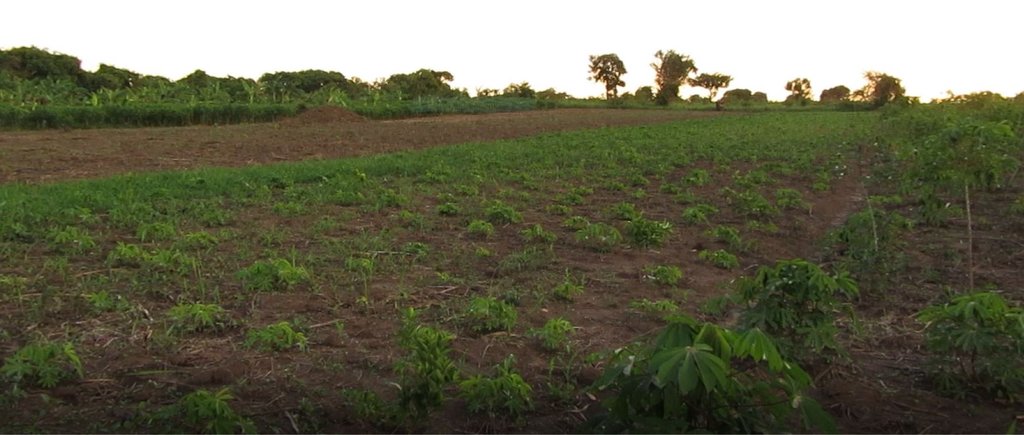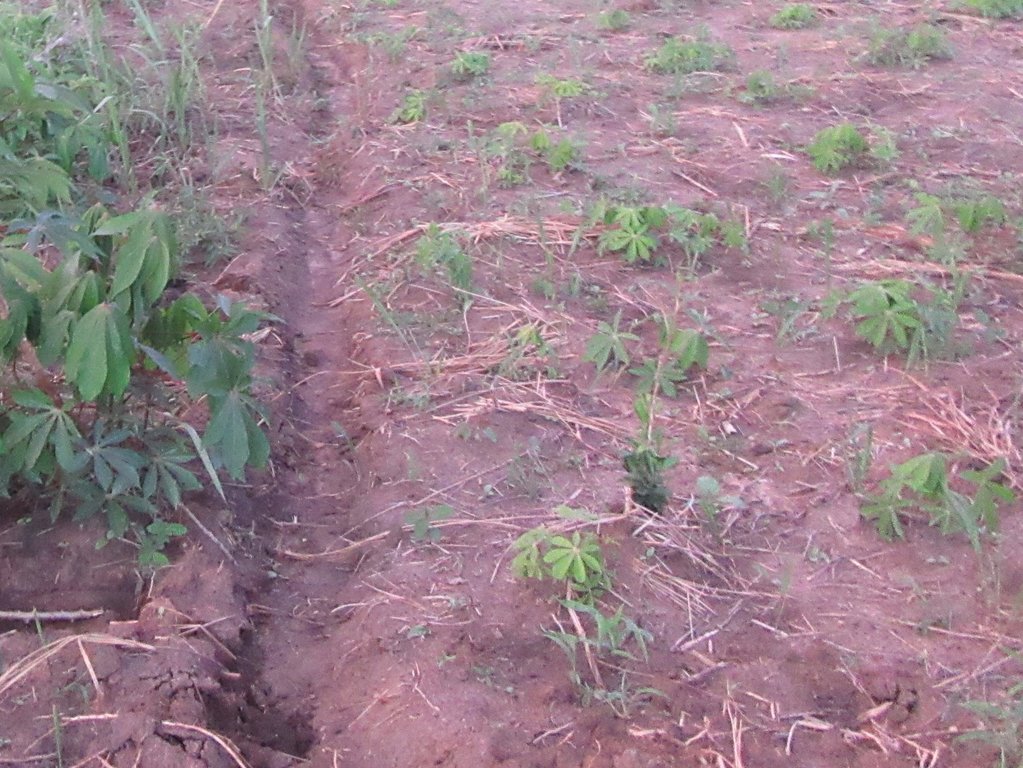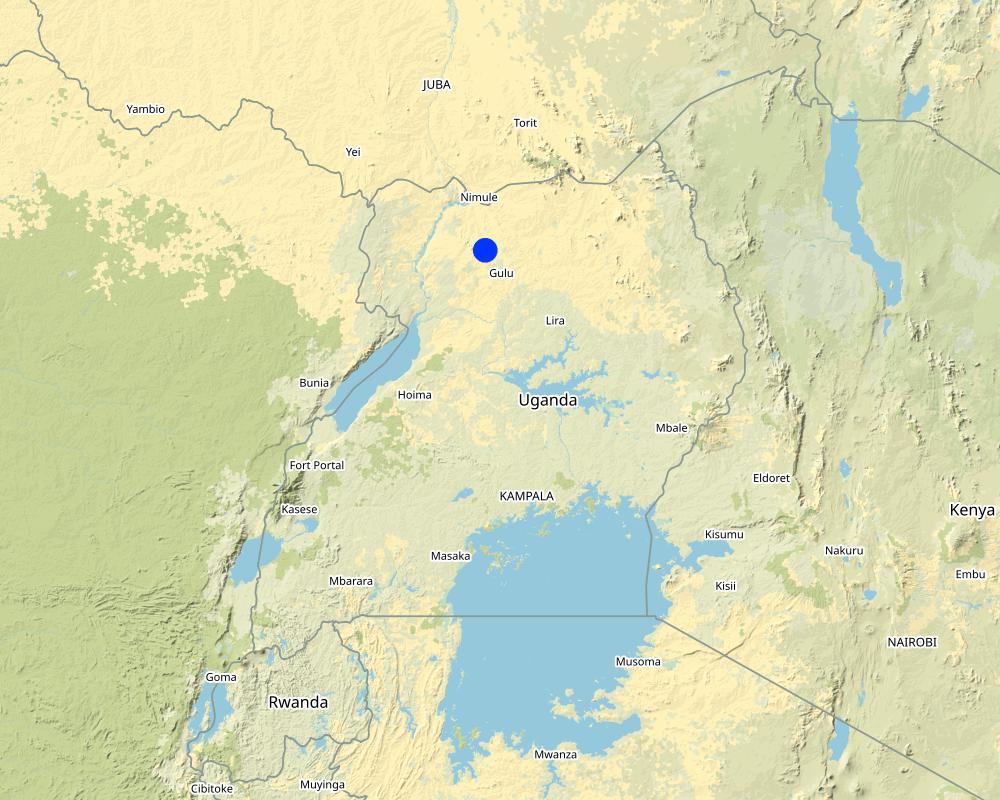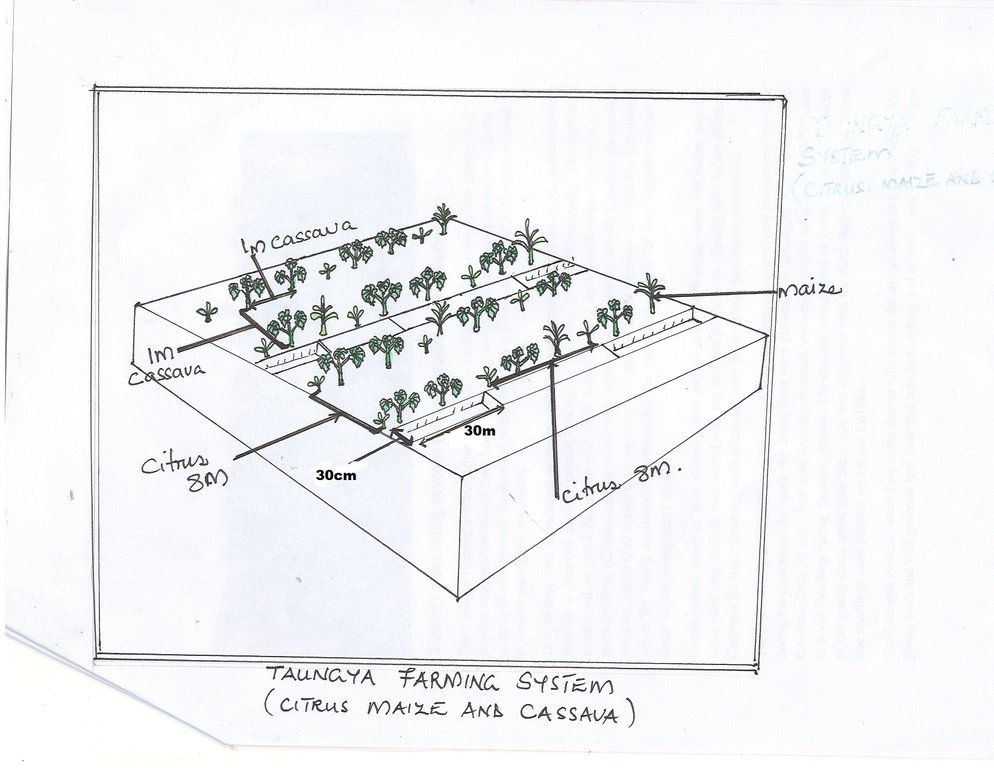Taungya Agroforestry System for Increased Production, Food Security, Soil Fertility and Household Income [乌干达]
- 创建:
- 更新:
- 编制者: Jalia Namakula
- 编辑者: JOY TUKAHIRWA, Kamugisha Rick Nelson
- 审查者: Drake Mubiru, Nicole Harari, Luigi Piemontese, Udo Höggel
technologies_2830 - 乌干达
查看章节
全部展开 全部收起1. 一般信息
1.2 参与该技术评估和文件编制的资源人员和机构的联系方式
关键资源人
土地使用者:
Opobo David
0782893944 / 0716765818
opobod@gmail.com
Pobbo Sub County, Amuru District
乌干达
1.3 关于使用通过WOCAT记录的数据的条件
(现场)数据是什么时候汇编的?:
09/05/2017
编制者和关键资源人员接受有关使用通过WOCAT记录数据的条件。:
是
1.4 所述技术的可持续性声明
这里所描述的技术在土地退化方面是否存在问题,导致无法被认为是一种可持续的土地管理技术?:
否
2. SLM技术的说明
2.1 技术简介
技术定义:
Taungya agro-forestry system (citrus,maize and cassava) involves the planting of crops in young tree plantations. The food crops are normally planted with trees to provide shade for the young seedlings especially during the dry season; the crop litter acts as mulch and compost after decomposition thereby regulating soil temperature, and improving soil moisture retention.
2.2 技术的详细说明
说明:
The Taungya Agroforestry farming practice is promoted in Northern Uganda that allows farmers to cultivate food crops in young tree plantations for increased production, food security, soil fertility improvement and household income. The practice was started in Malaysia in 1896 and because of the increase in average annual temperatures in Uganda, it is gradually gaining momentum in Uganda.
This technology was established on 1.6 ha of land out of 10 ha owned by the farmer. It lies on a gentle slope and stretched to the wetland. On one field citrus (citrus sinensis) was planted as the major crop the other crops grown include; maize (zea mays) local variety and cassava an improved variety (manihot esculenta) NASE14.
The citrus is grown for purely commercial purposes, the maize and cassava grown for food security and also provides shade for the young citrus trees especially during the dry season.
Establishing the system involved bush clearing and ox ploughing. Digging planting holes, applying manure and drainage channels dug after the seedlings had firmly established.
The citrus seedlings were planted in 90 cm × 90 cm × 45 cm (width × length × depth) planting holes, excavated to conserve soil moisture during prolonged dry spells. The citrus spacing was 8 m × 8 m.
Within the citrus field, 30cm × 30 m mini drainage channels were made to drain excess water during the rainy season. The cassava was planted at 1 m × 1 m between the spaces of the citrus seedlings and then the maize was staggered within the field. Approximately 500 citrus seedlings were planted within the 1.6 ha.
In Taungya systems, the annual crops provide shade for the young trees and generate leaf litter which acts as mulch for moisture conservation and also enhances soil fertility. Taungya systems also increase household income because they allow crop diversification within the same field. The drainage channels reduce flood incidences on the field.
The system has a few challenges, for example during harvesting of cassava the citrus roots can be damaged, which affects their performance.
Establishing the drainage channels was labor intensive, thus the channels fall short of the recommended 60 cm recommended width.
2.3 技术照片
2.4 技术视频
日期:
26/05/2017
位置:
Pabbo Sub County, Amuru District, Northern Uganda
摄影师的名字:
Isa Aiga
2.5 已应用该技术的、本评估所涵盖的国家/地区/地点
国家:
乌干达
区域/州/省:
Northern Uganda
有关地点的进一步说明:
Pabbo Sub county , Amuru Districts
注释:
3.01642, 32.12677, The location lies in Pabbo sub-county Amuru District.
Map
×2.6 实施日期
注明实施年份:
2016
2.7 技术介绍
详细说明该技术是如何引入的:
- 通过项目/外部干预
注释(项目类型等):
Government programme of Operation Wealth Creation
3. SLM技术的分类
3.1 该技术的主要目的
- 改良生产
- 创造有益的经济影响
3.2 应用该技术的当前土地利用类型

农田
- 一年一作
- 多年一作(非木材)
主要农作物(经济作物及粮食作物):
Cassava, Bananas, Citrus and Maize
如果由于技术的实施而导致土地用途发生变化,则在技术实施前说明土地利的用途。:
rice cultivation
3.3 有关土地利用的更多信息
该技术所应用土地的供水:
- 雨养
注释:
Although the land is near the valley bottom the land user depends on rainfall.
每年的生长季节数:
- 2
具体说明:
Maize is grown twice in a season but citrus is a perenial crop, the channels were dug in the first season.
3.4 该技术所属的SLM组
- 农业林学
- 引水和排水
3.5 技术传播
具体说明该技术的分布:
- 均匀地分布在一个区域
如果该技术均匀地分布在一个区域上,请注明覆盖的大致区域。:
- < 0.1 平方千米(10 公顷)
注释:
The agro forestry system occupies 1.6 ha of land
3.6 包含该技术的可持续土地管理措施

农艺措施
- A1:植被和土壤覆盖层
- A2:有机质/土壤肥力
- A5:种子管理,改良品种

结构措施
- S3:分级沟渠、渠道、水道
3.7 该技术强调的主要土地退化类型

土壤水蚀
- Wt:表土流失/地表侵蚀

物理性土壤退化
- Pw:水浸

生物性退化
- Bc:植被覆盖的减少
3.8 防止、减少或恢复土地退化
具体数量名该技术与土地退化有关的目标:
- 防止土地退化
- 减少土地退化
注释:
The drainage channels were constructed to prevent flooding
4. 技术规范、实施活动、投入和成本
4.1 该技术的技术图纸
4.2 技术规范/技术图纸说明
The citrus was planted in a planting hole of, width(75cm), length(75cm), depth (30cm) at a spacing 3×3m. The cassava is an improved NARO ( National Agricultural Research Organisation) NASE14 planted at a spacing of 1m×1m. The maize, a local variety was planted staggeringly in the field. The drainage channels are narrow and measured at 30cm(width)×15cm(depth)×30m(length).
4.3 有关投入和成本计算的一般信息
具体说明成本和投入是如何计算的:
- 每个技术区域
注明尺寸和面积单位:
1.6 ha
其它/国家货币(具体说明):
UGX
注明美元与当地货币的汇率(如相关):1美元=:
3650.0
注明雇用劳工的每日平均工资成本:
3000/=
4.4 技术建立活动
| 活动 | 措施类型 | 时间 | |
|---|---|---|---|
| 1. | Bush clearing | 管理 | July 2016 |
| 2. | Ploughing | 农业学的 | August 2016 |
| 3. | Digging planting basins | 农业学的 | August 2016 |
| 4. | Manure application | 农业学的 | September 2016 |
| 5. | Planting | 农业学的 | September 2016 |
| 6. | Digging planting basins | 结构性的 | September 2016 |
| 7. | Digging trenches | 结构性的 | April 2017 |
注释:
The Citrus was planted in 2016, cassava ,maize and the drainage channels were excavated
4.5 技术建立所需要的费用和投入
| 对投入进行具体说明 | 单位 | 数量 | 单位成本 | 每项投入的总成本 | 土地使用者承担的成本% | |
|---|---|---|---|---|---|---|
| 劳动力 | Bush clearing | people | 5.0 | 75000.0 | 375000.0 | 100.0 |
| 劳动力 | Digging trenches | people | 5.0 | 20000.0 | 100000.0 | 100.0 |
| 劳动力 | Ploughing | people | 4.0 | 100000.0 | 400000.0 | 100.0 |
| 劳动力 | Diging basins | people | 550.0 | 1000.0 | 550000.0 | 100.0 |
| 设备 | Planting | holes | 550.0 | 500.0 | 275000.0 | 100.0 |
| 植物材料 | Citrus | plants | 550.0 | 3000.0 | 1650000.0 | |
| 植物材料 | Cassava | bag | 8.0 | 20000.0 | 160000.0 | |
| 肥料和杀菌剂 | Manure | bag | 20.0 | 5000.0 | 100000.0 | |
| 其它 | Transport | 10.0 | 60000.0 | 600000.0 | 100.0 | |
| 技术建立所需总成本 | 4210000.0 | |||||
如果土地使用者负担的费用少于100%,请注明由谁负担其余费用:
Planting material was given by Operation Wealth Creation but establishment costs were borne by land users
4.6 维护/经常性活动
| 活动 | 措施类型 | 时间/频率 | |
|---|---|---|---|
| 1. | Weeding | 农业学的 | twice/season |
| 2. | Spraying with fungicide | 农业学的 | once/month |
注释:
The citrus has just established there maintenance activities are still few
4.7 维护/经常性活动所需要的费用和投入(每年)
| 对投入进行具体说明 | 单位 | 数量 | 单位成本 | 每项投入的总成本 | 土地使用者承担的成本% | |
|---|---|---|---|---|---|---|
| 劳动力 | Weeding | acres | 4.0 | 80000.0 | 320000.0 | 100.0 |
| 劳动力 | Spraying | acres | 4.0 | 20000.0 | 80000.0 | 100.0 |
| 设备 | Spray pump | piece | 1.0 | 120000.0 | 120000.0 | 100.0 |
| 肥料和杀菌剂 | Pesticides | Litres | 1.0 | 20000.0 | 20000.0 | 100.0 |
| 技术维护所需总成本 | 540000.0 | |||||
如果土地使用者负担的费用少于100%,请注明由谁负担其余费用:
All costs were borne by the land user
4.8 影响成本的最重要因素
描述影响成本的最决定性因素:
Availability of labour
5. 自然和人文环境
5.1 气候
年降雨量
- < 250毫米
- 251-500毫米
- 501-750毫米
- 751-1,000毫米
- 1,001-1,500毫米
- 1,501-2,000毫米
- 2,001-3,000毫米
- 3,001-4,000毫米
- > 4,000毫米
指定年平均降雨量(若已知),单位为mm:
1813.00
有关降雨的规范/注释:
The rainfall on set for the year 2017 started late i.e. in April instead of March
注明所考虑的参考气象站名称:
Gulu Meteorology Station
农业气候带
- 潮湿的
5.2 地形
平均坡度:
- 水平(0-2%)
- 缓降(3-5%)
- 平缓(6-10%)
- 滚坡(11-15%)
- 崎岖(16-30%)
- 陡峭(31-60%)
- 非常陡峭(>60%)
地形:
- 高原/平原
- 山脊
- 山坡
- 山地斜坡
- 麓坡
- 谷底
垂直分布带:
- 0-100 m a.s.l.
- 101-500 m a.s.l.
- 501-1,000 m a.s.l.
- 1,001-1,500 m a.s.l.
- 1,501-2,000 m a.s.l.
- 2,001-2,500 m a.s.l.
- 2,501-3,000 m a.s.l.
- 3,001-4,000 m a.s.l.
- > 4,000 m a.s.l.
说明该技术是否专门应用于:
- 不相关
5.3 土壤
平均土层深度:
- 非常浅(0-20厘米)
- 浅(21-50厘米)
- 中等深度(51-80厘米)
- 深(81-120厘米)
- 非常深(> 120厘米)
土壤质地(表土):
- 中粒(壤土、粉土)
土壤质地(地表以下> 20厘米):
- 细粒/重质(粘土)
表土有机质:
- 中(1-3%)
5.4 水资源可用性和质量
地下水位表:
< 5米
地表水的可用性:
好
水质(未处理):
良好饮用水
水的盐度有问题吗?:
否
该区域正在发生洪水吗?:
是
规律性:
偶然
关于水质和水量的注释和进一步规范:
Drinking water is got from the borehole
5.5 生物多样性
物种多样性:
- 中等
关于生物多样性的注释和进一步规范:
The farm has a diversity of crops including cassava, bananas and maize.
5.6 应用该技术的土地使用者的特征
定栖或游牧:
- 定栖的
生产系统的市场定位:
- 混合(生计/商业
非农收入:
- 收入的10-50%
相对财富水平:
- 丰富
个人或集体:
- 个人/家庭
机械化水平:
- 手工作业
性别:
- 男人
土地使用者的年龄:
- 中年人
说明土地使用者的其他有关特征:
He owns a fish pond and a maize processing mill and he keeps records of all incomes and expenditure
5.7 应用该技术的土地使用者拥有或租用的平均土地面积
- < 0.5 公顷
- 0.5-1 公顷
- 1-2 公顷
- 2-5公顷
- 5-15公顷
- 15-50公顷
- 50-100公顷
- 100-500公顷
- 500-1,000公顷
- 1,000-10,000公顷
- > 10,000公顷
这被认为是小规模、中规模还是大规模的(参照当地实际情况)?:
- 中等规模的
注释:
He owns 20 acres of land, average land holding in this community is 5 acres
5.8 土地所有权、土地使用权和水使用权
- customary
- customary
用水权:
- 社区(有组织)
5.9 进入服务和基础设施的通道
健康:
- 贫瘠
- 适度的
- 好
教育:
- 贫瘠
- 适度的
- 好
技术援助:
- 贫瘠
- 适度的
- 好
就业(例如非农):
- 贫瘠
- 适度的
- 好
市场:
- 贫瘠
- 适度的
- 好
能源:
- 贫瘠
- 适度的
- 好
道路和交通:
- 贫瘠
- 适度的
- 好
饮用水和卫生设施:
- 贫瘠
- 适度的
- 好
金融服务:
- 贫瘠
- 适度的
- 好
6. 影响和结论性说明
6.1 该技术的现场影响
社会经济效应
生产
生产故障风险
注释/具体说明:
The food crops provide shade to the young seedlings therefore reducing seedling growth failure.
收入和成本
农业投入费用
注释/具体说明:
Because litter from the crops grown maintainces soil moisture and shade reduces soil temperatures, the need for the farmer to regularly irrigate the citrus seedling during the dry season reduces.
收入来源的多样性
注释/具体说明:
The farmer expects to get multiple incomes from selling the citrus fruits and cassava
社会文化影响
食品安全/自给自足
注释/具体说明:
From the same piece of land, maize and cassava are available for food.
生态影响
水循环/径流
多余水的排放
注释/具体说明:
The channels drain excess water during the rainy season.
生物多样性:植被、动物
植物多样性
注释/具体说明:
Plant diversity is high because of mixed cropping (Cassava, Maize and Citrus)
6.2 该技术的场外影响已经显现
下游洪水
注释/具体说明:
Water that comes from the garden is diverted into neighbours fields
6.3 技术对渐变气候以及与气候相关的极端情况/灾害的暴露和敏感性(土地使用者认为的极端情况/灾害)
渐变气候
渐变气候
| 季节 | 气候变化/极端天气的类型 | 该技术是如何应对的? | |
|---|---|---|---|
| 年温度 | 增加 | 好 | |
| 年降雨量 | 减少 | 好 |
6.4 成本效益分析
技术收益与技术建立成本相比如何(从土地使用者的角度看)?
短期回报:
稍微积极
长期回报:
非常积极
技术收益与技术维护成本/经常性成本相比如何(从土地使用者的角度看)?
短期回报:
稍微积极
长期回报:
积极
注释:
It is only the maize that matures first therefore in the short term establishment costs are negative. Cassava and citrus are long term crops therefore benefits are realized much later.
6.5 技术采用
- 单例/实验
在所有采用这项技术的人当中,有多少人是自发地采用该技术,即未获得任何物质奖励/付款?:
- 90-100%
6.6 适应
最近是否对该技术进行了修改以适应不断变化的条件?:
否
6.7 该技术的优点/长处/机会
| 土地使用者眼中的长处/优势/机会 |
|---|
| The kind of ago-forestry improves food security |
| There is an increase in incomes from the sale of crops |
| The technology is good at reducing soil erosion. |
| 编制者或其他关键资源人员认为的长处/优势/机会 |
|---|
| The technology encourages optimal utilisation of land |
| Reduction of water logging |
6.8 技术的弱点/缺点/风险及其克服方法
| 土地使用者认为的弱点/缺点/风险 | 如何克服它们? |
|---|---|
| Citrus takes long to mature | Inter-crop with annuals |
| 编制者或其他关键资源人员认为的弱点/缺点/风险 | 如何克服它们? |
|---|---|
| Costly in terms of purchase of different seed varieties | Join farmers associations for agricultural loan to pay after harvest and sale. |
| If the cassava is not properly spaced it can interfere with root movement | Plant the trees away from drainage channel |
7. 参考和链接
7.1 信息的方法/来源
- 实地考察、实地调查
1 person
- 与土地使用者的访谈
1 person
7.3 链接到网络上可用的相关信息
标题/说明:
Evaluation of agroforestry systems for maize (Zea mays) productivity in South Africa
URL:
https://www.tandfonline.com/doi/abs/10.1080/02571862.2018.1459898
链接和模块
全部展开 全部收起链接
无链接
模块
无模块


